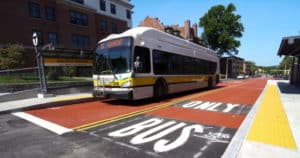
An MBTA bus drives through new bus-only lanes in Boston's Jamaica Plain neighborhood. Photo courtesy of the MBTA
Boxing Day was no holiday in the Massachusetts Legislature, where lawmakers advanced a laundry list of bills that would expire without action in the next six days.
The House and Senate returned to action Thursday and shipped more than a dozen measures to Gov. Maura Healey’s desk, most of them local bills affecting individual communities or public employees.
The branches also pushed a couple dozen other proposals forward in the pipeline, tackling topics ranging from school bus cameras to bus-only lanes.
Some of the bills that moved Thursday had been idling for months, while others more recently stepped into the spotlight.
Thursday’s action included a bill newly advanced by the Senate Ways and Means Committee allowing installation of school-bus traffic cameras (S 3005).
Under the camera bill, cities and towns could choose to install monitoring devices on school buses to record nearby vehicles that fail to stop. Any images or video could only be obtained for purposes other than enforcement of failing to stop, or defending against such an allegation, by a court order, according to a Senate Ways and Means Committee bill summary.
The House approved the school bus camera bill (H 4940) in July.
Meanwhile, the MBTA and other regional transit authorities could use bus-mounted camera systems to enforce dedicated bus lanes and bus stops under a bill (S 2884) the House passed Thursday, after it gained traction in that chamber’s Ways and Means Committee.
Motor vehicles that stop or park in bus-only lanes could face fines ranging from $25 to $125, while those parked at bus stops could be fined $100 under the bill, which passed the Senate in July. Sen. Brendan Crighton at the time said cars blocking bus lanes can hamper public transit service and create hazards for passengers, particularly those with disabilities.
The MBTA is in the process of reworking its bus network to improve connections between neighborhoods and new job centers, and making sure most lines run high-frequency service with a bus at least every 15 minutes every day, all day. But to make that work, T officials say they need local officials to install and help enforce dedicated lanes to make sure buses don’t get stuck in traffic.
Data from the T released last falls shows its early crop of experimental bus lanes saved riders hundreds of hours per week and made the bus lines that use them significantly more reliable. Transit experts say this improved reliability will be key to realizing buses’ potential as a cheaper way of expanding transit service and attracting more riders to help pay for the system.
New York City’s MTA has successfully used automated cameras to enforce its own bus lanes since June. That transit agency said in just the first two months of use, bus speeds increased and collisions dropped 20 percent. Only 9 percent of New York City drivers committed a second bus lane violation after getting their first fine, the MTA said.
Tuesday, Dec. 31 is the final day of the 2023-2024 lawmaking term. Any bills that do not make it all the way through both branches to Healey’s desk before the final gavel on New Year’s Eve will die, forcing backers to restart from step one when the next two-year session begins the following day.
Banker & Tradesman staff writer contributed to this report.





